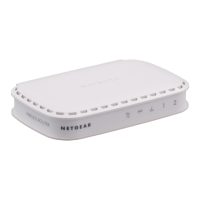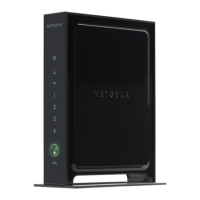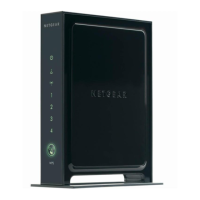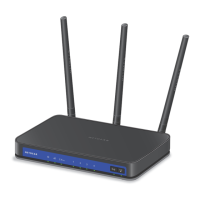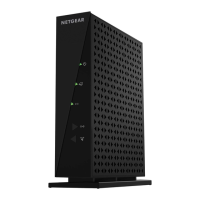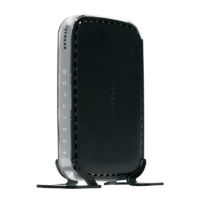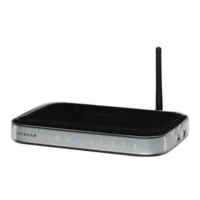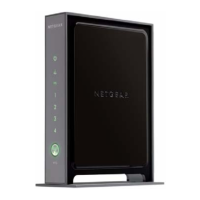Do you have a question about the NETGEAR WNR614 and is the answer not in the manual?
Describes front/back panels, status LEDs, and ports.
Optimal positioning for wireless signal range and avoiding interference.
Instructions for connecting modem, router, computer, and verifying connections via LEDs.
Steps for wired and wireless connection using WPS or SSID.
Explains internet, WiFi, and router login purposes.
Using NETGEAR genie for initial setup and configuration.
Guided process to detect and configure internet connection settings.
Options for configuring connection without a login or with a login.
Modifying Maximum Transmission Unit for potential performance improvements.
Viewing and modifying Wide Area Network configuration.
Setting up a DMZ server and changing the router's device name.
Configuring LAN IP, subnet, and DHCP server options.
Specifying the range of IP addresses assigned by the DHCP server.
Disabling the router's DHCP server feature.
Assigning fixed IP addresses to specific devices.
Using WPS for simple wireless device pairing.
Configuring SSID, channel, mode, and broadcast.
Changing WPA/WPA2 encryption and passphrase.
Creating a separate wireless network for visitors.
Enabling/disabling the wireless radio and setting schedules.
Controlling device access based on MAC addresses.
Configuring WPS and setting up Wireless Distribution System.
Configuring the router for WDS as a base station or repeater.
Manually defining routes for network traffic.
Listing all connected wired and wireless devices.
Enabling UPnP for automatic network device discovery.
Checking for, downloading, and installing router firmware updates.
Changing the router's administrator password and setting up recovery.
Viewing hardware, firmware, LAN, wireless status, and internet connection details.
Viewing WAN IP, subnet mask, DNS server, and connection type.
Monitoring traffic statistics for WAN and LAN ports.
Viewing detailed wireless and guest network configurations.
Restarting the router to apply changes or resolve issues.
Backing up, restoring, or erasing router settings.
Steps to recover forgotten admin or WiFi passwords.
Diagnosing weak signals or failure to find the network.
Using front panel LEDs to diagnose router issues.
Resolving problems preventing login to the router interface.
Troubleshooting the router's inability to obtain an IP address from the ISP.
Addressing issues with loading web pages after obtaining an IP address.
Resolving issues specific to PPPoE internet connections.
Using ping utility to test network connectivity and paths.
Resolving problems related to IP address assignment and network access.
Details on default router login, network, and wireless configurations.
Information on hardware, protocols, dimensions, and environmental factors.
Describes front/back panels, status LEDs, and ports.
Optimal positioning for wireless signal range and avoiding interference.
Instructions for connecting modem, router, computer, and verifying connections via LEDs.
Steps for wired and wireless connection using WPS or SSID.
Explains internet, WiFi, and router login purposes.
Using NETGEAR genie for initial setup and configuration.
Guided process to detect and configure internet connection settings.
Options for configuring connection without a login or with a login.
Modifying Maximum Transmission Unit for potential performance improvements.
Viewing and modifying Wide Area Network configuration.
Setting up a DMZ server and changing the router's device name.
Configuring LAN IP, subnet, and DHCP server options.
Specifying the range of IP addresses assigned by the DHCP server.
Disabling the router's DHCP server feature.
Assigning fixed IP addresses to specific devices.
Using WPS for simple wireless device pairing.
Configuring SSID, channel, mode, and broadcast.
Changing WPA/WPA2 encryption and passphrase.
Creating a separate wireless network for visitors.
Enabling/disabling the wireless radio and setting schedules.
Controlling device access based on MAC addresses.
Configuring WPS and setting up Wireless Distribution System.
Configuring the router for WDS as a base station or repeater.
Manually defining routes for network traffic.
Listing all connected wired and wireless devices.
Enabling UPnP for automatic network device discovery.
Checking for, downloading, and installing router firmware updates.
Changing the router's administrator password and setting up recovery.
Viewing hardware, firmware, LAN, wireless status, and internet connection details.
Viewing WAN IP, subnet mask, DNS server, and connection type.
Monitoring traffic statistics for WAN and LAN ports.
Viewing detailed wireless and guest network configurations.
Restarting the router to apply changes or resolve issues.
Backing up, restoring, or erasing router settings.
Steps to recover forgotten admin or WiFi passwords.
Diagnosing weak signals or failure to find the network.
Using front panel LEDs to diagnose router issues.
Resolving problems preventing login to the router interface.
Troubleshooting the router's inability to obtain an IP address from the ISP.
Addressing issues with loading web pages after obtaining an IP address.
Resolving issues specific to PPPoE internet connections.
Using ping utility to test network connectivity and paths.
Resolving problems related to IP address assignment and network access.
Details on default router login, network, and wireless configurations.
Information on hardware, protocols, dimensions, and environmental factors.
| Switch type | - |
|---|---|
| Power connector | DC-in jack |
| Installed SFP modules quantity | 0 |
| Basic switching RJ-45 Ethernet ports type | Fast Ethernet (10/100) |
| Basic switching RJ-45 Ethernet ports quantity | 5 |
| 10G support | No |
| Networking standards | IEEE 802.11b, IEEE 802.11g, IEEE 802.11n |
| User guide | Yes |
| Package type | Box |
| Cables included | DSL, LAN (RJ-45) |
| Throughput | 300 Mpps |
| MAC address table | - entries |
| DHCP features | DHCP server |
| Security algorithms | WEP, WPA, WPA2 |
| Product color | White |
| Compatible products | PC, Mac, iPhone, iPad, & Android |
| Flash memory | 4 MB |
| Maximum data transfer rate | 300 Mbit/s |
| Compatible operating systems | Microsoft Windows 7, 8, Vista, XP, 2000, Mac OS, UNIX, Linux |
| Depth | 140 mm |
|---|---|
| Width | 173 mm |
| Height | 35 mm |
| Weight | 200 g |
